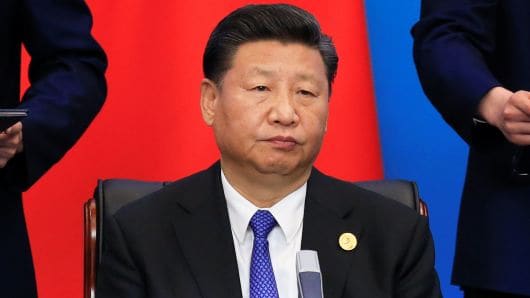
China’s economy, much more vulnerable to exports, is likely to take a bigger hit than the U.S. from the escalating trade war.
Even so, China’s leaders are not likely to blink any time soon, particularly with mid-term elections approaching, and President Donald Trump is not expected to back down.
The U.S. slapped tariffs of 10 percent on $200 billion in Chinese goods, and China retaliated by putting tariffs on $60 billion in U.S. goods. Economists expect Chinese growth to take a hit of 0.5 to 0.6 percentage points in 2019 if tariffs are raised to 25 percent on Jan. 1 as the U.S. has announced.
“If you put tariffs across the board on both countries…it’s a four times bigger hit to China because they export four times as much as they import,” said Ethan Harris, head of global economics at Bank of America Merrill Lynch.
“The tariffs announced so far could have as much as a half percent impact on Chinese growth…In the U.S. we’ve got even less because first of all the shock is much smaller, and the momentum is so strong in the economy, it gets lost in the numbers,” he said.
BofA now expects Chinese growth in 2019 of 6.1 percent, even with the offsetting positive from China’s stimulus programs. JP Morgan expects China’s growth to slow by 0.6 percentage points because of the weakening of both export and import activity.
The current tariffs are likely to affect U.S. growth modestly, by 0.1 or 0.2 percentage points, but if the 10 percent tariffs on $200 billion on Chinese goods are raised to 25 percent, and China retaliates, the hit could be 0.2 or 0.3 percentage points in 2019, Harris said. BofA expects 2019 U.S. GDP to grow by 2.7 percent.
Harris said the trade war may not end until U.S. consumers feel the effects, or people become concerned that it will be prolonged and continually escalating.
So far, the stock market is ignoring the tariffs and potential economic damage, but strategists said a sharp sell off because of tariffs could affect financial conditions — and get the Trump administration’s attention.
“The market still thinks somehow there’s going to be a deal between the U.S. and China…I think it misunderstands what Trump wants,” said Marc Chandler, Bannockburn Global Forex chief market strategist. “He has a two pronged battle — one is against the supply chains and one is against China’s practices. He wants China to change in a fundamental way.”
Chinese Premier Li Keqiang said Wednesday that his government is able to help the Chinese economy withstand challenges, but that the economy is inevitably affected by changes in the global economy and trade. “Indeed, we’re facing greater difficulties in keeping stable performance of the Chinese economy,” he said.
“In a sense, what the trade war is doing is forcing China to mimic the U.S. and put a big stimulus on. It makes sense for them to acknowledge there’s going to be a bit of a slowdown,” said Harris. “They’re not going to hit their forecast…People are used to the idea that they always hit their target so missing it raises questions about the fundamental health of the economy. If growth is so weak they can’t come closer to their target, it may raise questions about whether the true growth rate is weaker.”
For the the U.S., the 10 percent on $200 billion is equal to a $20 billion tax on U.S. consumers. “That’s a very small number. That compares to the tax cut…The first year impact was $150 billion,” Harris said. “This $200 billion escalation is another step toward bigger tariffs, but it’s still small. The real risk from the trade wars is less about tariffs going up and hurting consumer spending. It’s more about confidence.”
China has plenty of weapons at its disposal, and strategists say it would first seek retaliating tariffs. It also could stand back and let its currency fall as it had this summer.
Yuan or renminbi “depreciation is a more effective way to do damage control: with a mild depreciation against the dollar, the tariff impact could be largely offset,” wrote J. P. Morgan economists.
However, China risks capital flight if it were to let the currency weaken too much. That could also escalate tensions with the U.S. Trump has already threatened to put tariffs on every Chinese import, amounting to an additional $267 billion in goods.
“I think that most of the weakness of the renminbi has already happened. They don’t want their currency to drop too sharply,” said Harris. He said the weakness is a natural response as is the strengthening of the dollar, and it is not manipulation.
“I think in the long run, the tools China can use are letting its currency weaken, putting pressure on U.S. companies in China and shifting its reserves out of dollars and into other currencies,” Harris said. He said China could sell U.S. Treasurys and buy European or Japanese sovereign debt. “Those are all extreme measures and wouldn’t be likely unless we went to across the board tariffs on all Chinese products, but the reason they are a last resort is they all hurt both sides.”
The Treasury Department on Tuesday reported that China’s holdings of Treasury securities dropped to the lowest level since January. The change was modest, and strategists dismissed it as being unintentional.
“If China really was trying to send the U.S. a signal, it would not be so ambivalent,” said Chandler.























